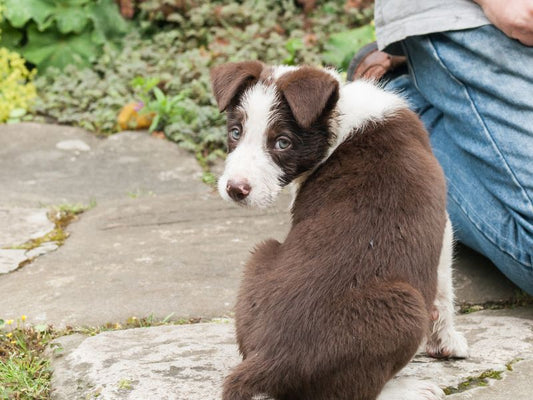Toller Dog Guide:
- Breed Information
- Size
- Appearance
- Training & Behaviour
- Health issues
- Grooming
- Exercise
- Nutrition
- Is a Toller Dog right for me?
- Where can I get a Nova Scotia Duck Tolling Retriever?
What is a Nova Scotia Duck Tolling Retriever?
The Nova Scotia Duck Tolling Retriever is a medium-sized dog, with boundless amounts of energy and a friendly, affectionate nature.
Bright and alert, active and full of fun, they’re capable of working hard and are officially classed as a gun dog by the Kennel Club.
Originating in Canada, Tollers sometimes get referred to as the 'Little River Duck Dog' in reference to the district they were bred.
They have a water repellent coat and webbed feet, making them excellent swimmers often used to lure and retrieve water birds.
Their appearance is striking, with coats that range in shades from light orange to deep crimson red, a waving tail with a paint-dipped tip, and white markings on their paws and face.
These pups make great family dogs or working dogs, providing they are able to live an active lifestyle to keep them out of trouble!

Which breeds make a Toller dog?
It’s thought that the origins of the Duck Tolling Retriever breed can be traced to a St John’s Water Dog and a Dutch Tolling Kooikerhondje.
They could be a mix of Retriever, Setter, Spaniel and Farm Collie, however the exact breeds are not known.
Features:
| Height Range |
48 - 51 cm (adult males) 45 - 48 cm (adult females) |
| Weight Range |
17 - 23 kg |
| Lifespan |
10 - 14 years |
| Breed |
Possible mix of Retriever, Setter, Spaniel and Farm Collie |
| Other Names | Toller Dog, Duck Tolling Retriever, Nova Scotia Duck Toller, Tolling Retriever, Nova Scotia Dog, Canadian Water Dog, Little Red Duck Dog, Little River Duck Dog, Yarmouth Toller |
How big do Nova Scotia Duck Tolling Retrievers get?
Classed as a medium breed, the Nova Scotia Duck Tolling Retriever is the smallest type of retriever breed registered with the American Kennel Club, but despite their small size, they’re full of personality and playfulness.
On average, a fully grown adult can range from 45-51cm tall, weighing anywhere between 17 - 23kg. Compared to their Labrador friends who grow to 22.5 - 38kg, Tollers are agile dogs suited to an active life.
Appearance:
Tollers are known for their beautiful crimson coats, almond-shaped eyes, and fluffy feathering around their ears, chest and back legs.
Their colouring can range, from shades of light orange to deep red. More often than not, they are accompanied by white markings on their paws and chest - and sometimes even on their face and tail too!
Nova Scotia dogs are medium in build and love an active lifestyle. Thanks to their webbed feet, Tollers are excellent swimmers, and their thick double coat with its soft undercoat helps to keep them insulated when swimming in cold waters.
Be warned though, their fluffy double coat does come with shedding, so prepare to invest in a decent hoover and watch the fur float away when it’s shedding season.
Health Issues:
On the whole, Nova Scotia Duck Tollers are relatively healthy, with an average life expectancy of 10 - 14 years.
But like all breeds, each dog is unique, and it’s not uncommon for them to occasionally experience neurological or cardiac disorders, and sometimes orthopaedic problems can occur as a result of being overweight.
A few common health concerns related to this breed include:
- Addison’s disease: When the adrenal glands don’t produce the right amount of hormones needed to control levels in the blood.
- Eye conditions: Most commonly progressive retinal atrophy (PRA), a degenerative disease of the retina, and Collie eye anomaly, a genetic mutation of the gene that determines the eyes development.
- Hip dysplasia: Which can be inherited from parents or caused by uneven skeletal growth.
It’s worth asking your breeder for full health records, or checking in with your vet if you have concerns. If you’ve rescued your Toller dog and want a little reassurance on their health, you could consider paying for a DNA test to further explore their genetic health.
So long as you feed them a healthy diet, give them adequate exercise and mental stimulation, and keep up with regular check-ups at the vet, you’ll give your Toller the best chance of a happy and healthy life.
Are Nova Scotia Duck Tollers easy to train?
A Nova Scotia Duck Toller is smart and learns well. Their eagerness to work and please their owner makes training fairly straightforward, but their independence and desire to do things their own way can be a little disruptive so they’ll need mentally stimulating training sessions that aren’t too repetitive.
By keeping training sessions short and practicing more frequently (in 5 minute intervals, 3 - 5 times a day) you’ll stand a better chance of keeping their full attention, resulting in a more rewarding experience for both human and dog.
Positive reinforcement works best for this breed, so avoid shouting at or punishing your Duck Tolling Retriever puppy for not listening.
They’re generally motivated by anything from their favourite dog toy, to tasty treats and positive praise!
💡 Top Tip: When praising your Toller dog, pat them under their chin or chest instead of on top of their head - they find this more caring and comfortable.
How much time does a Toller need for socialisation and training?
Even though they have a friendly and outgoing personality, a Nova Scotia Dog can be wary when meeting new people, so it’s important to start socialisation as soon as your Toller puppy has had its vaccinations.
The typical window for socialisation and training is 3 - 12 weeks, so even before you welcome them home, their training should have begun.
Once you bring a puppy home, it becomes your responsibility to continue the work if you want your Toller to have good manners.
You can start to introduce them to new experiences and other humans as soon as they are fully vaccinated.
How much exercise does a Toller need?
Come rain or shine, this dog can go, go, go! A simple stroll around the block won’t come close to giving them what they need.
To manage their energy, they’ll need an absolute minimum of 1 hour of exercise per day, but it's likely this high energy breed will want more than that.
With a high prey drive, and innate desire to be active, this breed is a popular choice of working gun dog, but if hunting isn't for you, then agility classes are a great way to give your Tolling Retriever the mental and physical stimulation they need.

You can also let them play around in water as this Canadian water dog loves to swim, just make sure you keep a close eye on them and use a long line training lead if you’re still working on your dog's recall training.
Whatever you do, ensuring your Toller's exercise requirements are met is really important if you don’t want to experience mischievous behaviour.
Invest in suitable toys - such as balls for them to chase, or a squeaky toy for them to play with.
This will help keep them entertained throughout the day and prevent boredom from taking control. A tired Toller is a good Toller after all!
How long should you walk a Nova Scotia Duck Tolling Retriever for?
As mentioned above, Tollers are active pups who need a minimum of one hour of exercise per day.
Whether you choose to head out for a long hike, or split your walks into two smaller chunks is up to you, but ensuring their exercise needs are met will always be important.
You won’t be able to skip a day with this breed either, as they’ll be ready and raring to go each time.
Physical games, like fetch or tug of war, are great for building a stronger bond, or you could try a few doggy brain games like hide and seek to keep them mentally stimulated.

Can you run with a Duck Toller?
As well as their love for swimming, the Duck Tolling Retriever makes a great running partner due to their energetic nature.
Swapping one of your walks for a jog around the park is another great way to release pent up energy while building and maintaining both your dog’s fitness and your own.
Grooming and Bathing:
A Toller's gorgeous crimson coat is one of their most striking features, but maybe not the accessory you imagined to cover your interiors!
Their medium-length coat sheds during season changes, which is why creating a home grooming routine will help keep them looking their best.
When it comes to bathing, they’re fairly low maintenance and can be bathed as and when they need it.
Although it is worth noting that they shouldn’t be bathed more than once every four weeks. So if you want to keep that freshly bathed smell, try a Dog Deodorising Spray for a quick freshen up instead.
A big part of their grooming routine will include brushing, which will need to be done weekly (daily during shedding season) to help remove loose fur and prevent any mats or tangles from forming.
The feathering fur around their ears, neck and under arms is finer so will need closer attention as it can easily knot.
Do Nova Scotia Duck Tolling Retrievers shed a lot?
Yes. Due to their double coat, Tolling Retrievers are natural shedders and will shed fur when moving from warm to cold seasons.
By brushing your Toller's coat daily you can tame the shedding and remove any loose fur before it gets the chance to settle around the house.
💡 Top Tip: To reduce fly-away fur when you go for a stroke, create an evening grooming routine - this could also help settle them before bed, letting them know it’s time to calm down.
Nutrition and Feeding:
With their active nature, it's no surprise that this retriever breed has a healthy appetite. However, Tollers are also known to be able to pile on the pounds if not fed correctly.
The primary choice for most Nova Scotia Dog owners is a raw food diet, which is increasing in popularity within the dog world.
Their diet should consist of healthy fats, proteins and vegetables that are packed with the vitamins and minerals required to maintain optimum health and performance.
No matter what, you should always research dog nutrition and opt for high-quality dog food, consulting your vet for the best recommendations.
If you do notice your pup gaining unwanted weight, try reducing their treat intake and switching to a weight management diet.
When it comes to feeding your Toller, you should avoid taking them for exercise immediately before or after food to reduce the risk of bloat.
As a small dog with a deep chest, they can be more susceptible to gastric dilatation-volvulus (GDV) so it’s best to take precautions.
Is a Toller dog right for me?
When welcoming any dog to the family, you should consider your own needs as well as the needs of the specific breed you're considering.
Toller dogs need an active lifestyle and a family willing to give them plenty of mental and physical stimulation.
They aren't the best dogs for first-time owners, and if it's a laid back pooch you're after, then this is definitely not the breed for you!
Pros:
- Gorgeous coat colours. For those who love a red dog coat, the Toller is hard to ignore - and it’s low maintenance needs for bathing can be a big plus.
- Easily motivated and eager to please which make for successful training.
- Super affectionate for a hardworking dog. If their exercise needs are met they love a cuddle and a belly rub.
- Great with children with an overall family-friendly nature, but will still require supervision as with any other breed.
- Active breed who love exercise. Whether walking, running, or chasing a ball, they’re sure to be able to keep up with you.
- Natural hunters with a high prey drive - perfect if you’re looking for a working gun dog.
Cons:
- They blow their coat seasonally and require weekly/daily brushing to keep it looking it’s best - so if a home covered in fur isn’t for you, avoid double coated breeds.
- High prey drive, so if you have a cat they’re likely to chase it!
- High play drive with boundless amounts of energy and can go and go until your arm is ready to fall off, and then expect you to use the other arm!
- Easily bored and distracted without adequate stimulation.
- Require a firm owner as although they are easy to train, they’re super smart and can exploit power if you’re not able to be firm with them.
- Wary of strangers, so not the best if you’re looking for a guard dog.
- Vocal when excited. Their shrill bark is loud and high pitched, so it’s worth considering where you live to avoid annoying neighbours.
Where to get a Nova Scotia Duck Tolling Retriever:
If you’ve done your homework and decided a Nova Scotia Duck Tolling Retriever is the right dog for you, then start by contacting trustworthy UK breeders to get your name down on a waitlist.
You can use The Kennel Club’s database to find a litter near you.
Alternatively, if you’d prefer to rescue or foster a Toller, head to The Toller Club and contact their Rescue Coordinator who can help you get your new furry friend!



